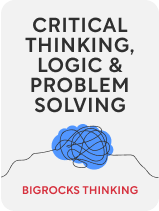

This article is an excerpt from the Shortform book guide to "Critical Thinking, Logic & Problem Solving" by Bigrocks Thinking. Shortform has the world's best summaries and analyses of books you should be reading.
Like this article? Sign up for a free trial here.
Do you have great ideas but struggle to communicate them effectively? How can critical thinking help you structure a story?
The authors of Critical Thinking, Logic & Problem Solving explain how to give good presentations and effectively get your ideas across by using critical thinking. They advise you to use stories to persuade and inform your audience.
Continue reading to learn how to structure a story by using critical thinking principles and techniques.
How to Structure a Story
The authors place particular emphasis on storytelling, as it helps your audience understand and remember your ideas. It can also build an emotional connection, which further enhances their comprehension and retention. They offer recommendations on how to structure a story depending on your goal.
Method #1: Situation-Complication-Resolution
To persuade others, they recommend the situation-complication-resolution approach. First, you explain the situation, then the complication (the problem), and then the solution that you’re recommending to them.
(Shortform note: Another structure for persuasive storytelling is the Attention, Interest, Desire, and Action structure. This begins with an attention-grabbing statement or idea followed by another idea to retain their interest. Then you turn their attention to their desire, explaining what they can get out of what you’re saying. Finally, you provide them with a call to action as to how to achieve the desired result. Like the situation-complication-resolution approach, this method is persuasive because you end with a recommendation that your audience can act on to resolve the problem or desire you’ve brought to their attention.)
Method #2: Hook-Meat-Payoff
To explain information to your audience, you can use the hook-meat-payoff structure. First give your hook, where you pique their interest by letting them know what they can get out of your presentation. Follow that up with the meat, where you explain the topic you’re trying to get across to them. Finally, explain exactly how they can apply your information to their lives.
(Shortform note: This structure is great for efficiently delivering your information in easy-to-understand chunks, and the hook is a great opportunity for pulling your audience in. There are several different types of hooks you can use, the most common of which is an anecdote. Anecdotes humanize the speaker to their audience and also help the audience connect the speaker to the subject. Other options for a hook include a video, a statement of belief, a joke, or a rhetorical question. The meat should then be delivered in discrete pieces that are easy for the audience to understand, and the payoff should include a call to action.)
Method #3: Freytag’s Pyramid (Five Acts)
You can also structure your stories by breaking them into acts. One of the act structures the authors recommend is the five-act structure, or Freytag’s pyramid, which consists of:
- The exposition, which introduces the context and circumstances of the story
- The rising action, in which you describe the events leading to the conflict
- The climax, which is the high point of your plot when the conflict is greatest
- The falling action, where the conflict gets solved and the moral of the story is revealed
- The denouement, or the end of the story
(Shortform note: Some representations of Freytag’s pyramid include seven pieces: exposition, inciting incident (the event that sparks the story’s action), rising action, climax, falling action, resolution, and denouement. In this case, the falling action would refer to the events that result from the climax, the resolution would be the part where the conflict is solved, and the denouement would still be the ending. Freytag’s pyramid was originally designed for tragic dramas, and in those structures, the denouement would be replaced with a catastrophe (the hero’s lowest point, such as a death or financial ruin). Freytag’s structure is ideal for stories with a strong, conclusive ending.)
Method #4: Pixar Story
Another framework they recommend is the Pixar story framework. This framework is great for not only conveying information and ideas but also evoking emotion in your audience. You can outline a story with this framework by filling in the blanks of six sentences:
- “Once upon a time, [blank]. Every day, [blank].” These two establish the setting and context of your story.
- “Then one day, [blank].” This establishes your story’s conflict.
- “Because of that, [blank]. And because of that, [blank].” This introduces your character’s challenge and how it affects them and other characters.
- “Until finally, [blank].” This explains how the character resolved their problem.
(Shortform note: An essential element of the Pixar framework is that your hero must have a goal that carries them through the story. Someone or something has to stand in the way of the hero achieving this goal, which is the source of the story’s conflict. It should also result in a lesson or personal growth for your hero, and this lesson is an optimal place to insert your own message to the audience.)

———End of Preview———
Like what you just read? Read the rest of the world's best book summary and analysis of Bigrocks Thinking's "Critical Thinking, Logic & Problem Solving" at Shortform.
Here's what you'll find in our full Critical Thinking, Logic & Problem Solving summary:
- A step-by-step guide for improving critical thinking and problem-solving skills
- Tips for conducting better research and finding reliable resources
- How to improve your communication and storytelling skills






